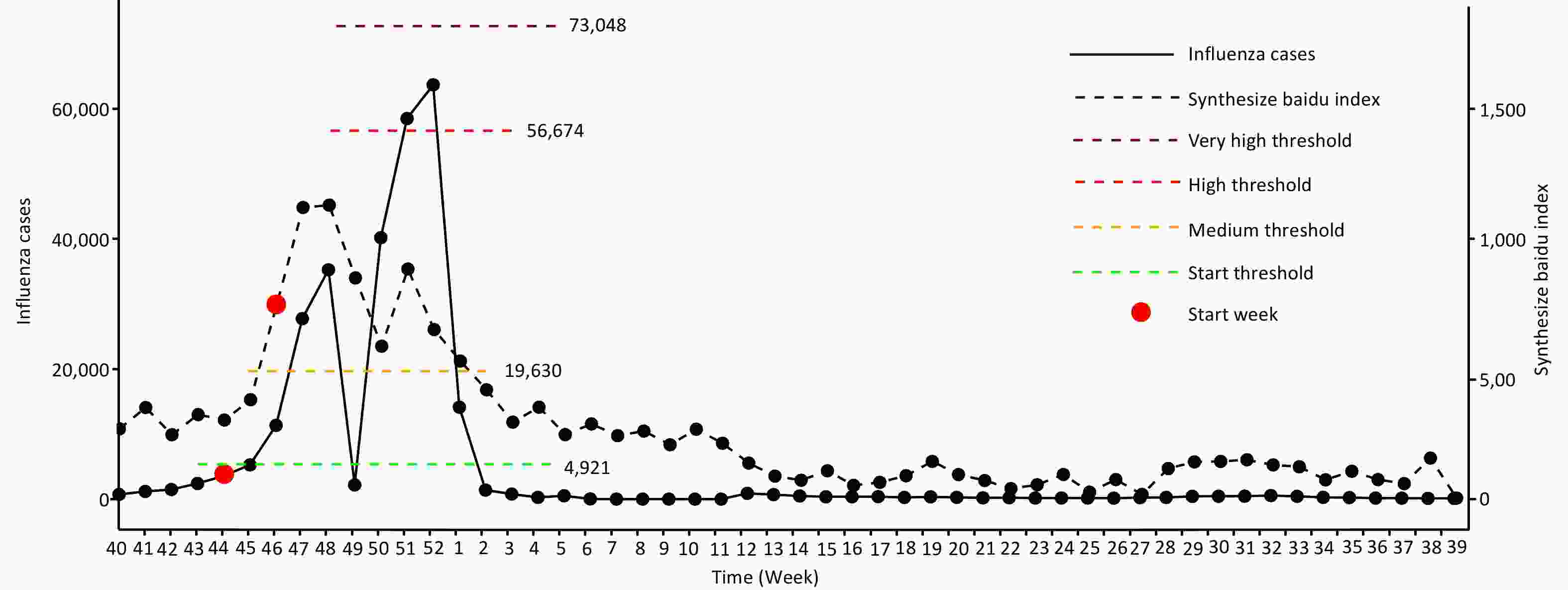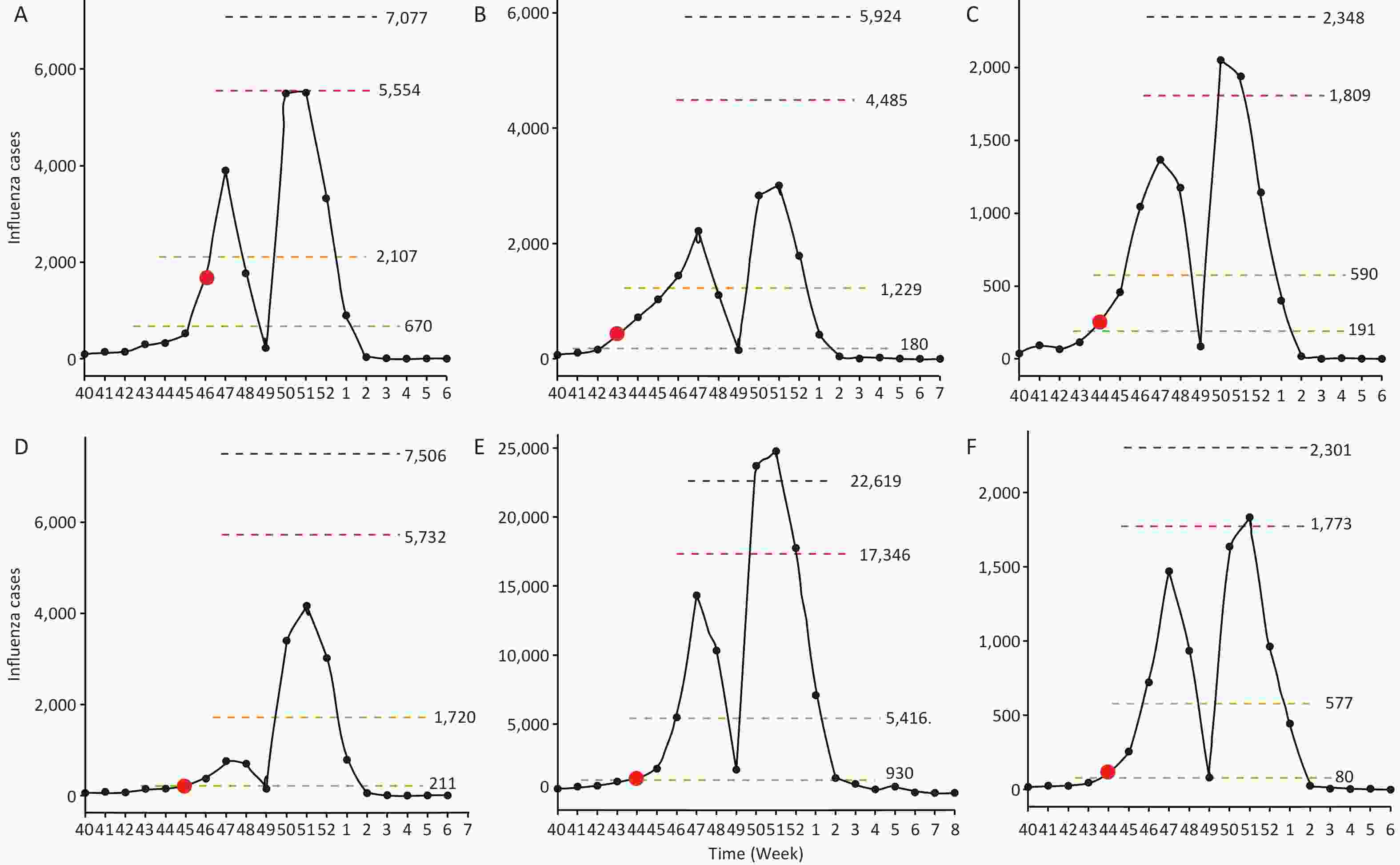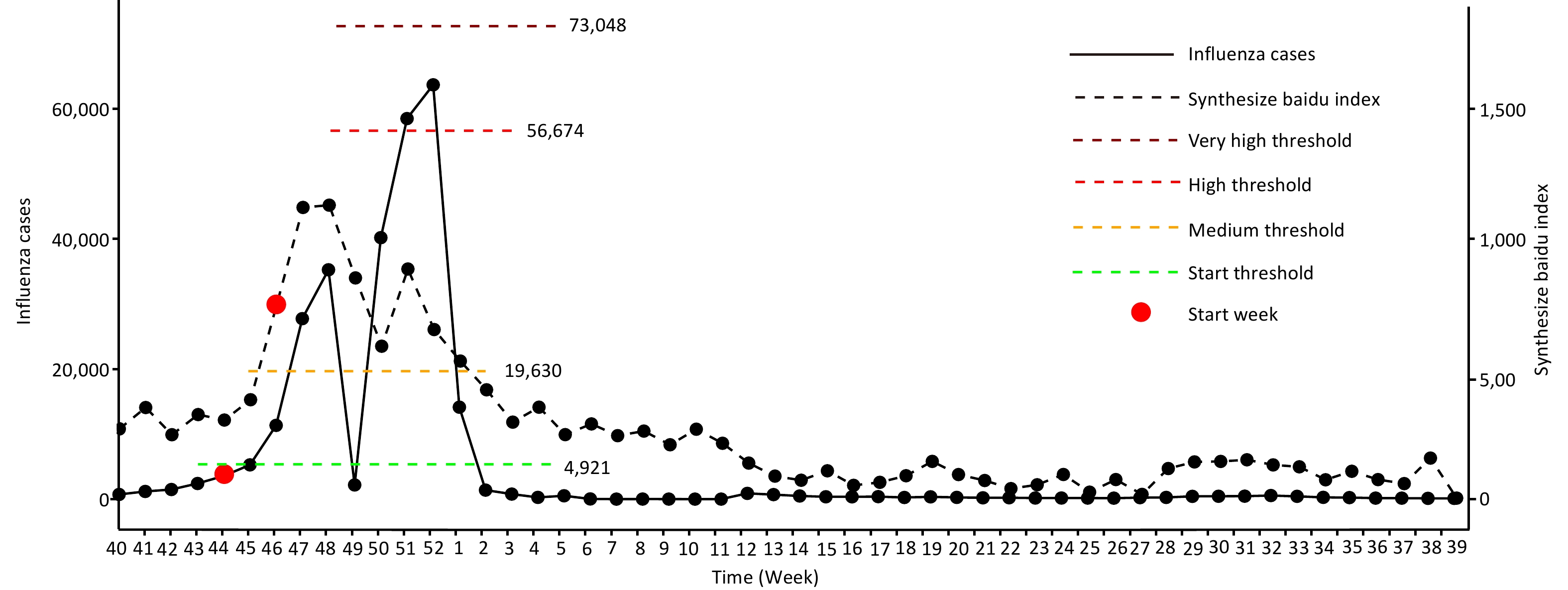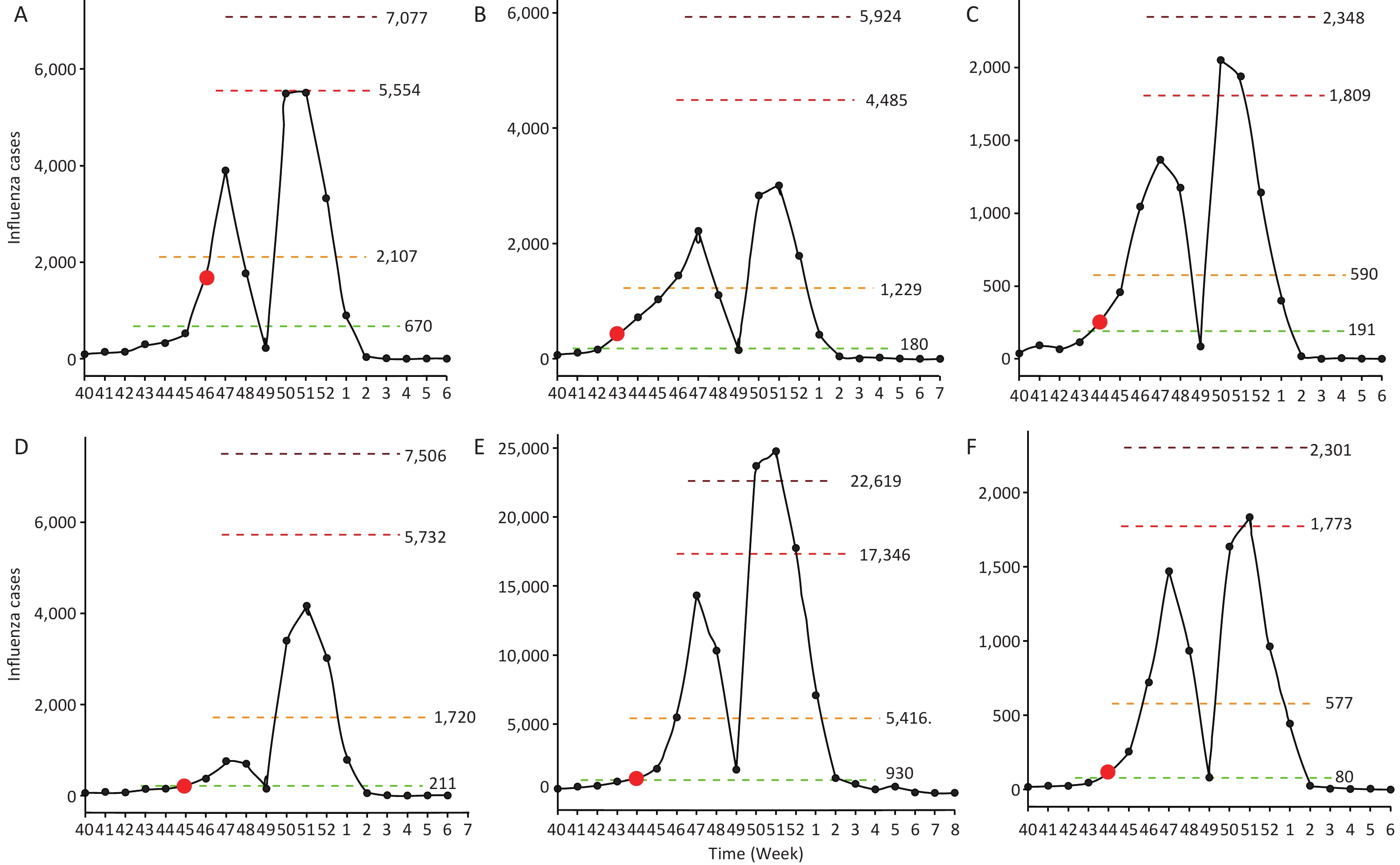-
Influenza, an acute respiratory infectious disease caused by the influenza virus, exhibits distinct seasonal patterns in China, with peak activity occurring in winter and spring in northern regions, and in winter and summer in southern areas[1]. The World Health Organization (WHO) emphasizes that early warning and epidemic intensity assessments are critical public health strategies for influenza prevention and control. Internet-based flu surveillance, with real-time data and low costs, effectively complements traditional methods. The Baidu Search Index, which reflects flu-related queries, strongly correlates with influenza trends, aiding in regional activity assessment and outbreak tracking[2].
In 2013, Vega et al.[3] applied The Moving Epidemic Method (MEM) to establish influenza epidemic thresholds and assess epidemic intensity[3,4]. The MEM relies solely on historical incidence data, demonstrating strong applicability. By updating thresholds in real time, the onset of an epidemic can be identified more accurately. The MEM has been widely and effectively used in temperate regions; however, its application in subtropical countries has rarely been reported. Hubei Province, located in Central China, has experienced a transient surge in influenza activity following the COVID-19 pandemic, necessitating the urgent development of early warning systems to monitor future influenza trends.
This study aims to apply the MEM to assess the intensity of influenza epidemics in Hubei Province during the 2023-2024 season, establish corresponding epidemic thresholds, and evaluate the performance of the MEM in this region. The findings will provide a reference for defining influenza epidemic thresholds and assessing epidemic intensity in Hubei Province, thereby offering a scientific basis for relevant health authorities to formulate effective prevention and control strategies, develop related policies, and allocate medical resources rationally.
-
The MEM involves historical incidence data and is primarily applicable to diseases with unimodal epidemics, preferably with ≥ 3 historical epidemic seasons[3]. It evaluates the influenza epidemic status and intensity of the target surveillance year by establishing graded thresholds. The influenza incidence data from 2020 to 2023 for various prefecture-level cities in Hubei Province were obtained from the Hubei Provincial Center for Disease Control and Prevention. According to the actual epidemic situation of reported influenza cases in various regions of Hubei from 2020 to 2023, only one epidemic peak was observed each year. Following Yang’s framework for MEM applicability[5], we selected regions with ≥ 3 influenza epidemic seasons between 2020-2024, including Hubei Province at the provincial level, and Wuhan, Xiangyang, Huanggang, Shiyan, Xianning, and Enshi Tujia and Miao Autonomous Prefecture at the prefecture level.
This study obtained the Baidu search index of influenza-related keywords through the Baidu website (https://index.baidu.com/v2/index.html#/). To avoid multicollinearity, we synthesized these keywords into a composite Baidu Index as the optimal surveillance factor, assigning higher weights to keywords that showed stronger correlations[6] (Additional file 1: Methods 1).
-
The MEM determines the start, end, and duration of disease epidemics using the Maximum Cumulative Sum Percentage (MAP) function based on historical data (Additional File 1: Methods 2). The model employs cross-validation by comparing epidemic and non-epidemic periods of the target season with pre- and post-epidemic thresholds estimated from historical epidemic seasons. The performance of the model was assessed using sensitivity, specificity, Youden’s index, and the Matthews correlation coefficient[4].
After model determination, the epidemic intensity of the target monitoring years was evaluated using the start and end thresholds, as well as thresholds for moderate, high, and extremely high epidemic intensity levels (Additional File 1: Methods 3). Statistical analysis and modeling were performed using the MEM package in R version 4.4.1, and the surveillance database was managed in Excel 2016.
-
Spearman correlation analysis results between the Baidu Index and influenza incidence (Supplementary Figure 1) revealed that "influenza virus" had the highest correlation, while "seasonal influenza" showed the lowest. The synthesized Baidu Index showed a correlation coefficient of 0.45, indicating potential utility as an early warning indicator for influenza.
-
Based on observed epidemic patterns from 2020 to 2023, a complete influenza season was defined as running from week 40 of each year to week 39 of the following year, and this structure was incorporated into the MEM model. At the provincial level, fitting the 2020–2023 data yielded an optimal $ \delta $ = 3.4, with cross-validation results of sensitivity = 0.93, specificity = 0.97, and Youden’s index = 0.9. Similarly, the optimal parameters were selected for the synthesized Baidu Index and at the prefecture- and city-level (Supplementary Table 1).
Province/City Epidemic period Epidemic period (weeks) Peak value (cases) Epidemic level during
the epidemic periodHubei Province Week 45 of 2023 to Week 2 of 2024 9 63,627 High prevalence level Wuhan Week 44 of 2023 to Week 2 of 2024 10 24,775 Extremely high prevalence level Shiyan Week 45 of 2023 to Week 2 of 2024 9 4,168 Medium prevalence level Huanggang Week 46 of 2023 to Week 2 of 2024 8 5,512 Medium prevalence level Xianning Week 44 of 2023 to Week 2 of 2024 10 1,834 High prevalence level Xiangyang Week 44 of 2023 to Week 2 of 2024 10 2,053 High prevalence level Enshi Tujia and Miao Autonomous Prefecture Week 43 of 2023 to Week 2 of 2024 11 3,005 Medium prevalence level Synthesized Baidu Index Week 46 of 2023 to Week 2 of 2024 8 1,226.6 Medium prevalence level Table 1. Influenza epidemiological intensity at the provincial (city) level in Hubei Province, 2023–2024
The model showed excellent fit, with Youden’s index exceeding 0.8 in most cases, and sensitivity and specificity above 0.9 for nearly all cities, confirming the MEM’s suitability for influenza surveillance and early warning in Hubei Province.
-
The MEM model indicated that the onset threshold for influenza epidemics in Hubei Province during 2023-2024 was 4,921 cases, and the end threshold was 4,387 cases. Thresholds for medium, high, and very high epidemic intensities were 19,630, 56,674, and 73,048 cases, respectively. The epidemic period lasted for nine weeks (week 45 of 2023 to week 2 of 2024), with a peak in week 52 (late December). Among the prefecture-level cities, the epidemic duration ranged from 8 weeks in Huanggang to 11 weeks in Enshi Tujia and Miao Autonomous Prefecture, concentrated mainly between week 43 of 2023 and week 2 of 2024.
The province as a whole reached a high epidemic level, and Wuhan City reached a very high epidemic level due to urbanization and population density. Xianning and Xiangyang had a high epidemic level, whereas Shiyan, Huanggang, and Enshi had a moderate level. The peak period of the synthesized Baidu Index coincided with the peak of influenza epidemics, and public attention to influenza increased simultaneously from late November to the beginning of the following year, suggesting that the Baidu Index can serve as an auxiliary early warning indicator for influenza (Figure 1 and 2,Table 1).

Figure 1. Influenza cases and Synthesized Baidu Index epidemiological intensity in Hubei Province, 2023 to 2024.

Figure 2. Influenza epidemiological intensity in major cities of Hubei Province, 2023 to 2024. (A) Huanggang; (B) Enshi Tujia and Miao Autonomous Prefecture; (C) Xiangyang; (D) Shiyan; (E) Wuhan; (F) Xianning.
The historical evaluation results from 2020 to 2023 showed that the epidemic levels in Hubei Province and its prefecture-level cities were at baseline during 2020/2021, low levels in 2021/2022 (Huanggang, Xianning, and Xiangyang reached moderate levels), and extremely high levels across all areas in 2022/2023 (Supplementary Table 2).
-
This study is the first to apply the MEM model to influenza epidemic intensity in Hubei after COVID-19, introducing the Baidu Index as an auxiliary early-warning indicator to establish a warning system. The findings indicate a high prevalence level in 2023-2024, with notable variation among prefecture-level cities. While peaks occurred within the seasonal range, high monitoring values require attention.
The Moving Epidemic Method (MEM) model indicated that the influenza epidemic period in Hubei Province during the 2023–2024 season lasted for nine weeks, peaking in week 52. This finding is consistent with previous studies demonstrating that influenza in Hubei typically exhibits a single-peak epidemic pattern, with peaks generally occurring between December and March of the following year[7]. The epidemic duration in prefecture-level cities was concentrated mainly between week 43 of 2023 and week 2 of 2024. Factors such as the winter-spring transition, high population density, air pollution due to heating in northern regions, and population mobility during the Spring Festival collectively facilitated influenza transmission, which also confirms the scientific rationale for completing vaccination before October[8]. Historical evaluation results from 2020 to 2023 showed that the epidemic levels in Hubei Province and its prefecture-level cities were at baseline during 2020/2021, while all areas reached extremely high levels in 2022/2023. Widespread non-pharmaceutical interventions (NPIs) during and after the COVID-19 pandemic helped suppress influenza transmission[9]. Post-pandemic analysis showed extremely high epidemic levels in 2022/2023, with overall influenza activity significantly higher than historical levels despite remaining within the seasonal range[10].
Determining the onset of influenza epidemics is important for medical resource allocation and vaccination guidance. By integrating real-time Baidu Index data with epidemic thresholds, surveillance efficiency can be improved, trends in influenza activity predicted in advance, and prevention strategies adjusted in a timely manner.
-
This study only covered single-peak epidemic regions. The generalizability of the findings is constrained by the single-region data, primarily applicable to central and northern areas exhibiting single-peak epidemic patterns. Future research should expand to provinces with dual-peak epidemic patterns. The Baidu Index may overestimate actual cases due to the influence of public opinion. Therefore, comprehensive analysis is required for practical applications.
-
Preventing influenza resurgence remains a public health priority. Determining the onset of influenza epidemics is of great significance for medical resource allocation and vaccination guidance. By integrating real-time Baidu Index data and establishing influenza epidemic thresholds, it is possible to enhance surveillance efficiency, predict influenza trends in advance, and adjust prevention and control strategies in a timely manner. The MEM model, with its simplicity and effectiveness, meets the needs of public health services and provides a scientific basis for influenza prevention and control.
Integrating Internet Search Data and Surveillance Data to Construct Influenza Epidemic Thresholds in Hubei Province: A Moving Epidemic Method Approach
doi: 10.3967/bes2025.109
- Received Date: 2025-08-17
- Accepted Date: 2025-03-07
-
Key words:
- Moving Epidemic Method /
- Influenza surveillance /
- Epidemic thresholds /
- Multi-source data
Abstract:
The authors declare no competing interests relevant to this article.
This retrospective study did not require ethical review.
&These authors contributed equally to this work.
| Citation: | Caixia Dang, Feng Liu, Hengliang Lyu, Ziqian Zhao, Sijin Zhu, Yang Wang, Yuanyong Xu, Yeqing Tong, Hui Chen. Integrating Internet Search Data and Surveillance Data to Construct Influenza Epidemic Thresholds in Hubei Province: A Moving Epidemic Method Approach[J]. Biomedical and Environmental Sciences. doi: 10.3967/bes2025.109 |








 Quick Links
Quick Links
 DownLoad:
DownLoad:
